-
-
-
-
Search
-
-
0
-
Shopping Cart
xProducts:0Cart Empty
-
by Francesco Medici
© Francesco Medici - all rights reserved 2020
“Forgive me my curiosity – what country do you hail from? You look to me like a Frenchman or an Italian.”[1]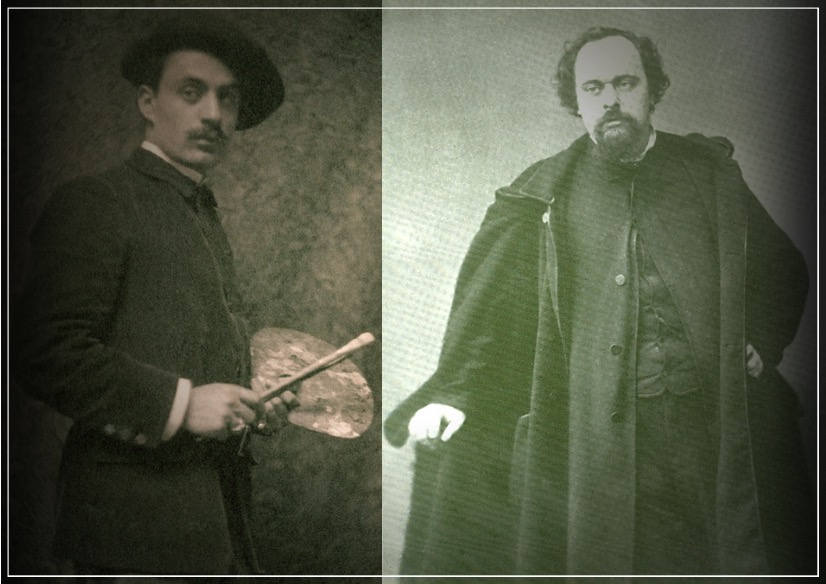
These appear to have been the first words spoken by Mary Haskell to Kahlil Gibran in the spring of 1904, during their first encounter at an exhibition of his paintings, which was held at the Harcourt Buildings in Boston.[2] Undoubtedly, it was not the first time that he was mistaken for an Italian whilst he was in the United States. The same thing had also happened when he was in Paris, as recounted by Yusuf Huwayyik, his study companion and fellow countryman.[3] Furthermore, Mary believed Gibran to be the reincarnation of Dante Gabriel Rossetti, poet and Pre-Raphaelite painter of Italian origins who was born in London in 1828 and died in 1882, the year before Kahlil was born.[4] Gibran himself also maintained he had a past life connection with Italy. One day, when speaking to Mary about his past existences, he told her that he once lived in Italy until the age of twenty-five.[5]
Gibran’s predilection for Italy can be traced back to his childhood in Lebanon, when he was six and his mother – according to some biographers – gave him some old Leonardo da Vinci prints (including The Head of Saint Anne), which made a considerable impression on the young boy:[6] “His passion for Leonardo possessed him from that hour, so much so, that when his father rebuked him for some childish misdemeanour, the boy flew into a rage and shouted;
‘What have you to do with me? I am an Italian!’”[7]
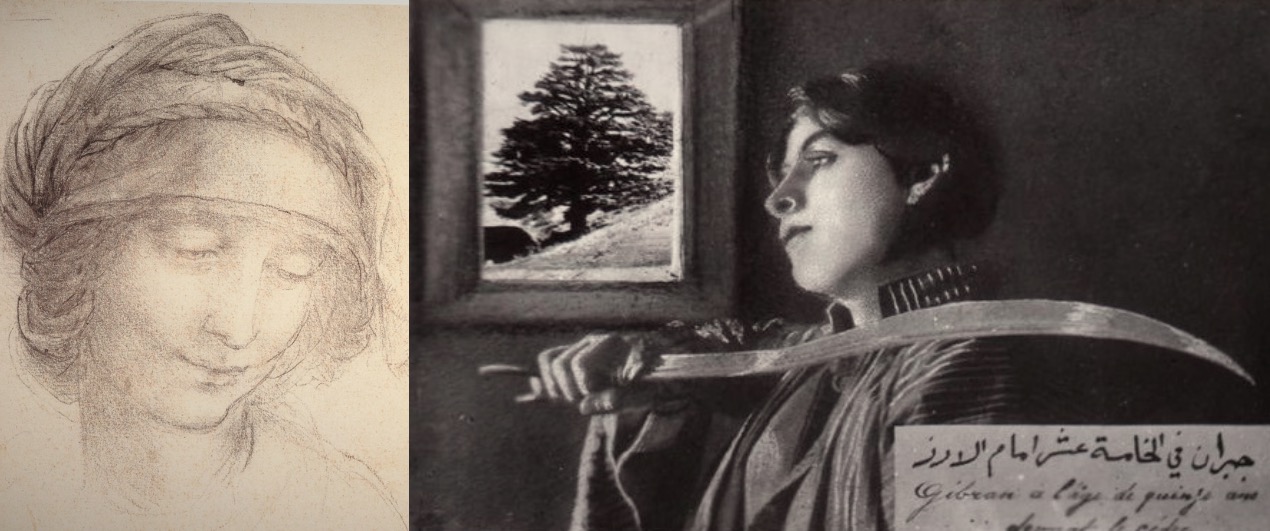 In 1895, during the journey from Beirut to Marseille – before setting sail on a boat bound from Boulogne to New York with his mother, half brother and two sisters – it is possible that the ship made a brief stopover in Italy, maybe in Naples, or more than likely it merely lapped briefly against Italy’s shores, allowing him to glimpse the country of his dreams only fleetingly. Years later, filled with nostalgia for his overseas homeland, he confided to Mary: “Syria and Italy are the two countries I love. I feel that I will be able to see Italy many times but not Syria.”[8]
In 1895, during the journey from Beirut to Marseille – before setting sail on a boat bound from Boulogne to New York with his mother, half brother and two sisters – it is possible that the ship made a brief stopover in Italy, maybe in Naples, or more than likely it merely lapped briefly against Italy’s shores, allowing him to glimpse the country of his dreams only fleetingly. Years later, filled with nostalgia for his overseas homeland, he confided to Mary: “Syria and Italy are the two countries I love. I feel that I will be able to see Italy many times but not Syria.”[8]
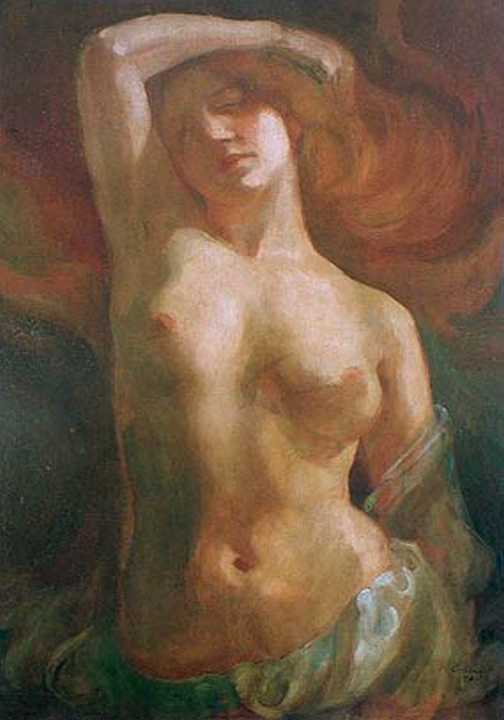 In 1908, when Kahlil enthusiastically welcomed Mary’s suggestion to go and study art in Paris at the Académie Julian, he also planned to finally visit Italy; testimony to this is a letter he sent on 28 March to his friend Ameen Guraieb, editor of the literary and informative Arab-American weekly Al-Mohajer (The Emigrant): “I told you ere your departure to Lebanon that I would spend a whole year in Paris, and now I have also decided to visit Italy after the expiration of my time in Paris. I intend to spend another year visiting Italy’s great museums and ruins and cities. I shall visit Venice,[9] Florence, Rome and Genoa; then I will return to Naples and board a boat to the United States.”[10] During his sojourn in the French capital, he met many young Italian artists and musicians[11] and among the models who posed for him was also a certain Rosina, “one of Botticelli’s nymphs […] a nice young Italian woman”[12] from Anticoli.[13]
In 1908, when Kahlil enthusiastically welcomed Mary’s suggestion to go and study art in Paris at the Académie Julian, he also planned to finally visit Italy; testimony to this is a letter he sent on 28 March to his friend Ameen Guraieb, editor of the literary and informative Arab-American weekly Al-Mohajer (The Emigrant): “I told you ere your departure to Lebanon that I would spend a whole year in Paris, and now I have also decided to visit Italy after the expiration of my time in Paris. I intend to spend another year visiting Italy’s great museums and ruins and cities. I shall visit Venice,[9] Florence, Rome and Genoa; then I will return to Naples and board a boat to the United States.”[10] During his sojourn in the French capital, he met many young Italian artists and musicians[11] and among the models who posed for him was also a certain Rosina, “one of Botticelli’s nymphs […] a nice young Italian woman”[12] from Anticoli.[13]
Gibran did not hesitate to suggest a trip to Italy to Huwayyik, who had mastered the Italian language and at that time was attempting to translate Dante’s The Divine Comedy into Arabic: “I always feel a certain loss because […] my feet don’t come in to contact with the earth of Rome, Florence, or Venice. I am constantly disturbed by this. How lucky you are, Yusuf, to have visited and lived in those cities! Do you think if we economized enough we would be able to save for a trip? You understand the language, so we would be spared the fees for a guide! […] How I would love to visit Florence and walk the streets of Dante, Giotto, [Beato] Angelico, Botticelli, Leonardo, Michelangelo, Machiavelli and many others who lived and worked in that city. I shall eternally grieve if I am denied the opportunity to climb to the top of Fiesole.”[14] In 1910, the two friends prepared “to leave shortly for Istanbul, Athens and Rome,”[15] but the cost of the journey revealed itself to be an insurmountable obstacle.
Kahlil took it as a sign of destiny, yet he did not lose hope: “But I feel that I must not go to Italy now. I hope that in two or three years I will be able to come to Italy and stay a whole winter.”[16] And again: “I feel […] that I must go back to Boston […] And perhaps in few years I shall be able to come back and see Italy."[17] At the end of June, he had to content himself with a month long trip to London with Ameen Rihani, whilst Yusuf departed for Italy alone.[18] Kahlil returned to Boston in November and after that, he would never leave America again.[19] Although a curriculum vitae written by Gibran himself in 1925 mentions a visit to Italy in 1908, such a statement does not seem to have basis in fact – if it were true, he would surely have left us some kind of records of his experience.
And so the relationship between Gibran and Italy, as much as it was profound and visceral within, was destined to remain indirect; and that far away peninsula in the heart of the Mediterranean, existed almost as a metaphysical location yet at the same time very real within his conscience and sensitivity. In a letter sent to Mary a few days after the 1908 Messina earthquake, he mourns the death of the thousands of victims of that tragedy as though they were his own countrymen: “The cries of the bereaved Italy has filled the heavens […] That fair land, so much loved by the Sun, is so hated by the heart of the ‘mighty deep.’ And Messina, the beautiful city, has become one great cemetery.[20] O how weak and insignificant Humanity seems before the blind forces of Nature. And Italy, the spiritual home of all the lovers of beauty, is the most hated enemy of those blind forces.”[21]
Gibran felt “the art of the Italians is in beauty,”[22] as he acknowledged one spring day in 1912, whilst walking with Haskell along Boston Common, America’s oldest public park: “This Common makes me ill […] It could be so glorious! Look what the Italians would do with a place like this. And see! (the civil War monument) Did you ever see anything uglier?”[23] In 1915 he wrote to his patroness and confidante: “The warmth of the Italian soul is in everything they do. Even the most commonplace thing that comes out of that Sun-loved land has a touch of the flame. God uses them.”[24]
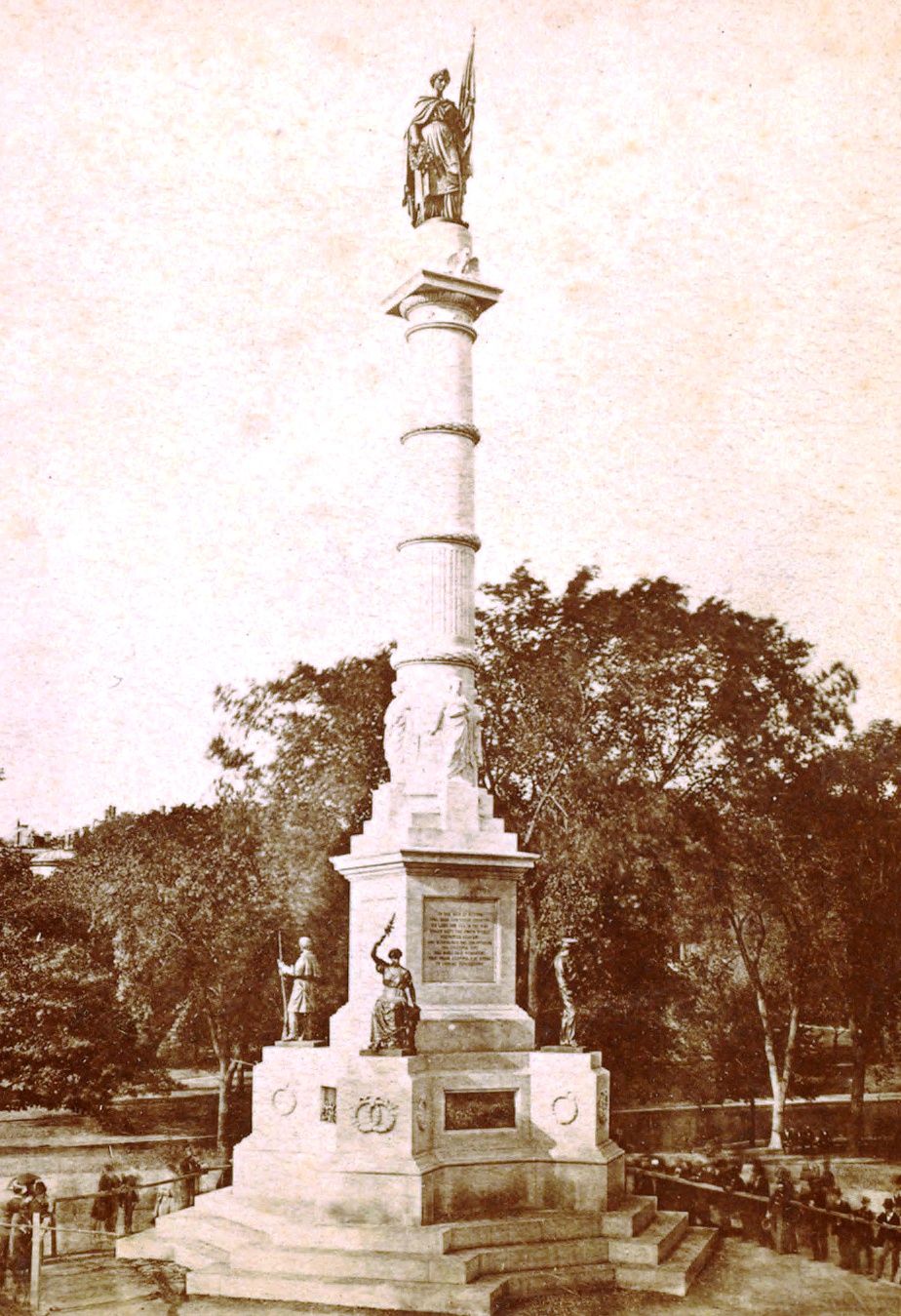 It is not surprising that his New York studio was home to “a small collection” of “Italian paintings.”[25] If Gibran was a great pioneer and brave innovator of the Romantic movement in modern Arabic literature, his relationship with figurative art was far more traditional. This was clear to him from early on. During his time in France he displayed a closer affinity with the classical tradition – from Greek art to masters like Andrea Mantegna, Sandro Botticelli, Perugino, Raphael, Titian,[26] Caravaggio – than with Fauvism, Cubism and the other “currents of artistic activity in Paris” that were, according to him, a “mad revolt […] in full swing against art and beauty.”[27]
It is not surprising that his New York studio was home to “a small collection” of “Italian paintings.”[25] If Gibran was a great pioneer and brave innovator of the Romantic movement in modern Arabic literature, his relationship with figurative art was far more traditional. This was clear to him from early on. During his time in France he displayed a closer affinity with the classical tradition – from Greek art to masters like Andrea Mantegna, Sandro Botticelli, Perugino, Raphael, Titian,[26] Caravaggio – than with Fauvism, Cubism and the other “currents of artistic activity in Paris” that were, according to him, a “mad revolt […] in full swing against art and beauty.”[27]
One of his favourite Italian artists was, as previously mentioned, Leonardo. As he wrote to the poet May Ziadah: “I have never looked on any of Leonardo da Vinci’s work without experiencing deep within my self the awareness that a part of his soul penetrates my own.”[28] The “Leonardoesque quality”[29] of many of Gibran’s paintings is obvious. One calls to mind for example, Silence, which clearly bears resemblance to Virgin of the Rocks. However, his admiration for Leonardo is possibly surpassed by that for Michelangelo, regarded by Gibran as a more complete personality, as he remarked in 1913 to Haskell: “Michelangelo was a great painter – he painted superman – superman physical and male.”[30] About ten years or so later, he was more precise: “Michelangelo was not the best painter, nor the greatest artist – but he was the greatest being of  the Renaissance painters. Leonardo was the greatest painter but Leonardo is on the earth – and on its remotest horizons. Michelangelo is one with the earth, and the horizons, and the sky.”[31]
the Renaissance painters. Leonardo was the greatest painter but Leonardo is on the earth – and on its remotest horizons. Michelangelo is one with the earth, and the horizons, and the sky.”[31]
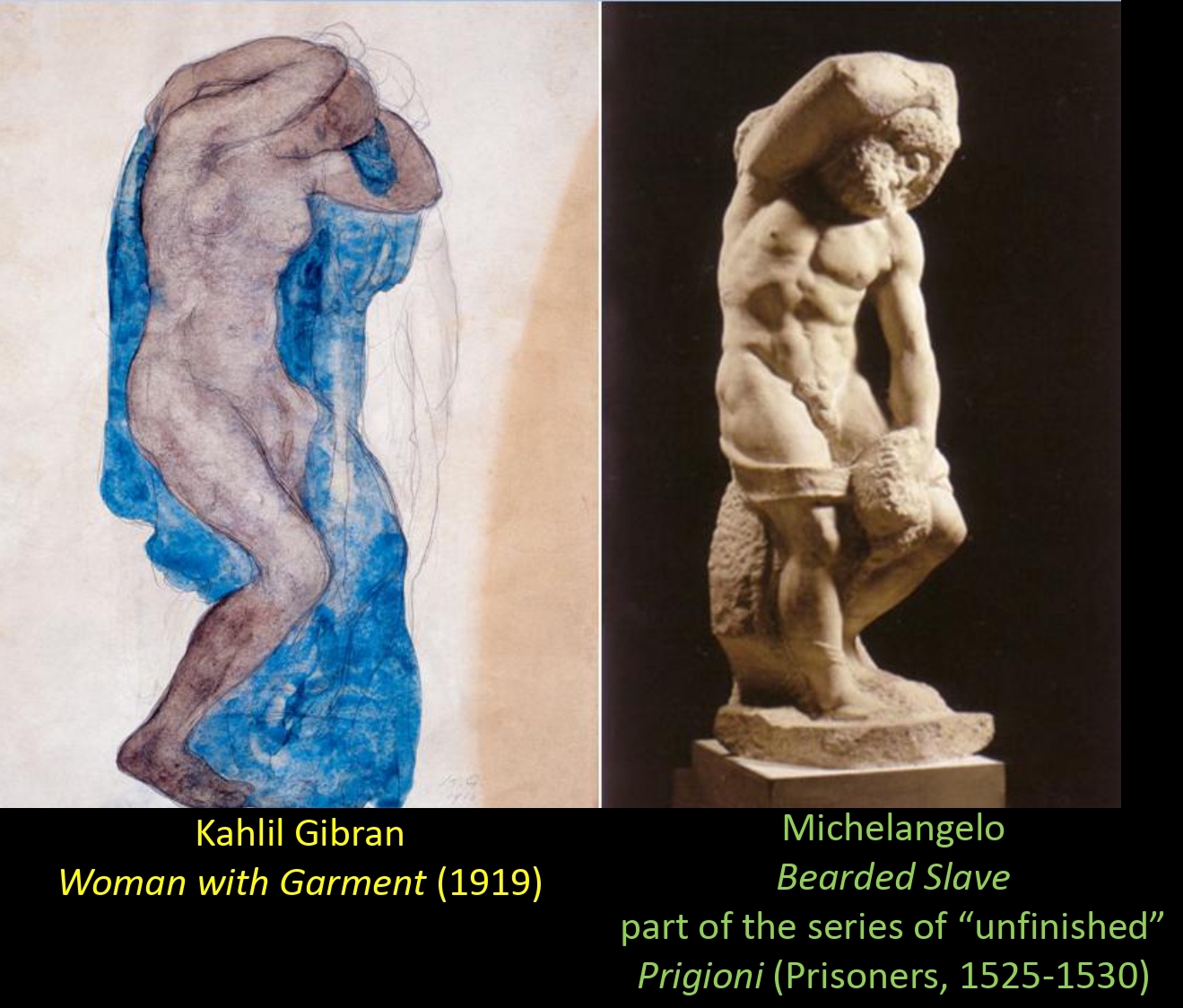 Michelangelo’s influence on Gibran art is detectable for example in three of his Twenty Drawings: Women with Garment recalls the Prisoners; The Flight displays similarities to The Creation of Adam from the Sistine Chapel in the Vatican City; The Triangle appears to resemble Christ’s deposition, similar to Michelangelo’s The Lamentation over the Dead Christ. Here we must also mention The Blind Poet, a drawing published in the 1925 July-September issue of The New Orient, which is clearly inspired by the renowned Michelangelo’s Pietà[32]. Gibran, who planned to write a book about him,[33] also admired Michelangelo the poet: “There is something in these sonnets of Michelangelo that touches my very depth… something that moves me as no other thing does. Perhaps they would have moved me much less if they were written by someone else – but this is a case where it so hard to divide between the man and his
Michelangelo’s influence on Gibran art is detectable for example in three of his Twenty Drawings: Women with Garment recalls the Prisoners; The Flight displays similarities to The Creation of Adam from the Sistine Chapel in the Vatican City; The Triangle appears to resemble Christ’s deposition, similar to Michelangelo’s The Lamentation over the Dead Christ. Here we must also mention The Blind Poet, a drawing published in the 1925 July-September issue of The New Orient, which is clearly inspired by the renowned Michelangelo’s Pietà[32]. Gibran, who planned to write a book about him,[33] also admired Michelangelo the poet: “There is something in these sonnets of Michelangelo that touches my very depth… something that moves me as no other thing does. Perhaps they would have moved me much less if they were written by someone else – but this is a case where it so hard to divide between the man and his 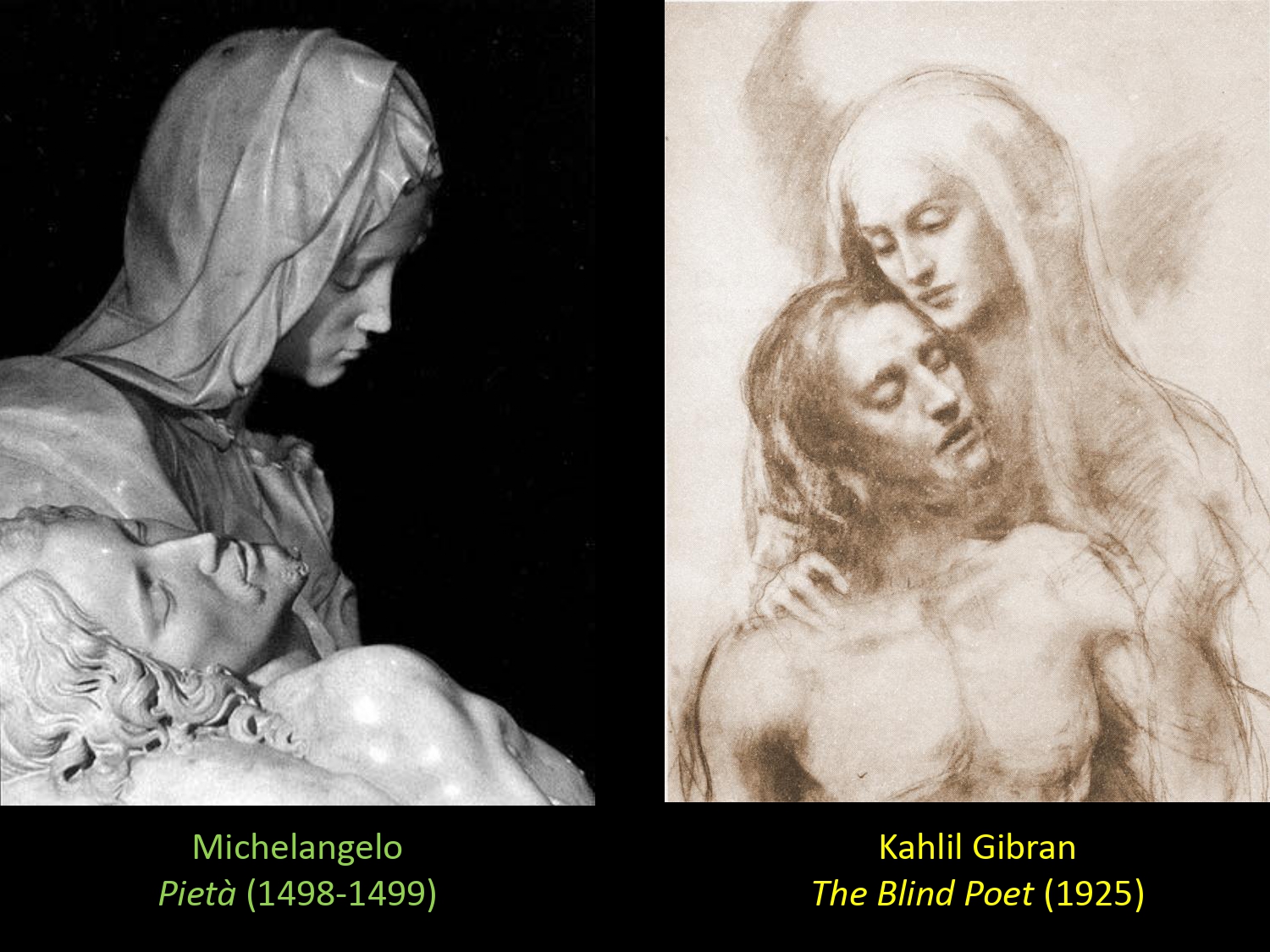 work. I have often felt that the greatest and the deepest element in Michelangelo’s soul was a dumb, motionless element. He went to his grave with a silent power in his heart… a power which he himself did not understand; and perhaps that is why he was always so unutterably sad.”[34]
work. I have often felt that the greatest and the deepest element in Michelangelo’s soul was a dumb, motionless element. He went to his grave with a silent power in his heart… a power which he himself did not understand; and perhaps that is why he was always so unutterably sad.”[34]
Gibran was also an avid admirer of the great authors of Italian literature. He probably read Dante Alighieri’s The Divine Comedy translated by Henry Francis Cary, published for the first time in London in 1814.[35] Huwayyik shared a touching anecdote, significant in understanding how much Gibran felt for the Florentine poet’s masterpiece. Kahlil insisted one evening that his friend read him an extract of his Arabic translation of the work: “How far did you get in translating The Divine Comedy? Many times you have promised to read some parts of it to me.” Yusuf satisfied his desire: “I read the translation of the fifth canto [of Inferno] to him, in which Dante discusses love. I repeated some phrases in Italian for the sake of clarity. I raised my voice when I came to a dramatic passage until I reached the last part where Dante says, ‘And I dropped like a dead body.’ I turned toward Gibran to see the effect my reading had to him, and there he was, with his head downward and his eyes wet with tears.”[36]
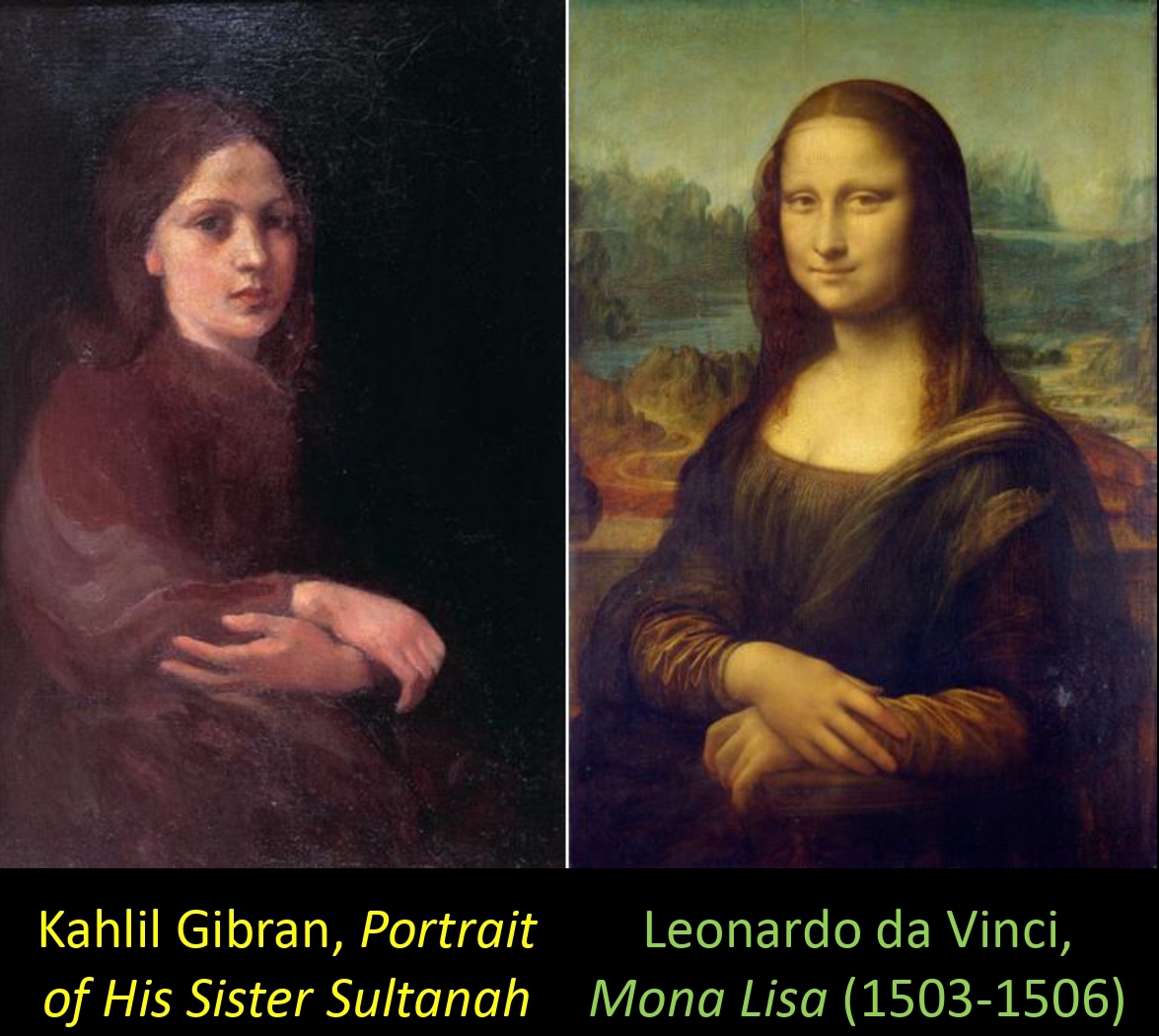 When Gibran offered his amanuensis Barbara Young his definition of ‘Genius’, he cited Dante as an example (“Genius is a protest against things as they seem to exist […] Dante […] was the greatest of all protests”)[37] – and he also listed him among the western authors whose influence was crucial on the Nahdah: “The renaissance in Arabic culture which has taken place within the last century has a strong admixture of western influences. Certainly, we are acquainted with your best. In Syria and Egypt we know Dante.”[38] In 1912 he told Mary that Selma Karamy, heroine of his novel The Broken Wings, was “half Beatrice and half Francesca.”[39] One must not forget that Francesca of Rimini, central figure of Dante’s fifth canto of Inferno and literary character of whom Gibran was particularly fond, is also the eponymous character of one of the dramas penned in 1902 by Decadent writer Gabriele D’Annunzio – among the principal masters of the myth of the femme fatale figure, as well as that of the female consoler and another of Gibran’s favourite authors – to whom he was even compared in his youth: “In the Arabic world […] they said then, I was 19 – that my work was like D’Annunzio. They said, ‘And D’Annunzio is nearing 40 and this youth is 19.’ I did not then know what they meant. I had never heard of
When Gibran offered his amanuensis Barbara Young his definition of ‘Genius’, he cited Dante as an example (“Genius is a protest against things as they seem to exist […] Dante […] was the greatest of all protests”)[37] – and he also listed him among the western authors whose influence was crucial on the Nahdah: “The renaissance in Arabic culture which has taken place within the last century has a strong admixture of western influences. Certainly, we are acquainted with your best. In Syria and Egypt we know Dante.”[38] In 1912 he told Mary that Selma Karamy, heroine of his novel The Broken Wings, was “half Beatrice and half Francesca.”[39] One must not forget that Francesca of Rimini, central figure of Dante’s fifth canto of Inferno and literary character of whom Gibran was particularly fond, is also the eponymous character of one of the dramas penned in 1902 by Decadent writer Gabriele D’Annunzio – among the principal masters of the myth of the femme fatale figure, as well as that of the female consoler and another of Gibran’s favourite authors – to whom he was even compared in his youth: “In the Arabic world […] they said then, I was 19 – that my work was like D’Annunzio. They said, ‘And D’Annunzio is nearing 40 and this youth is 19.’ I did not then know what they meant. I had never heard of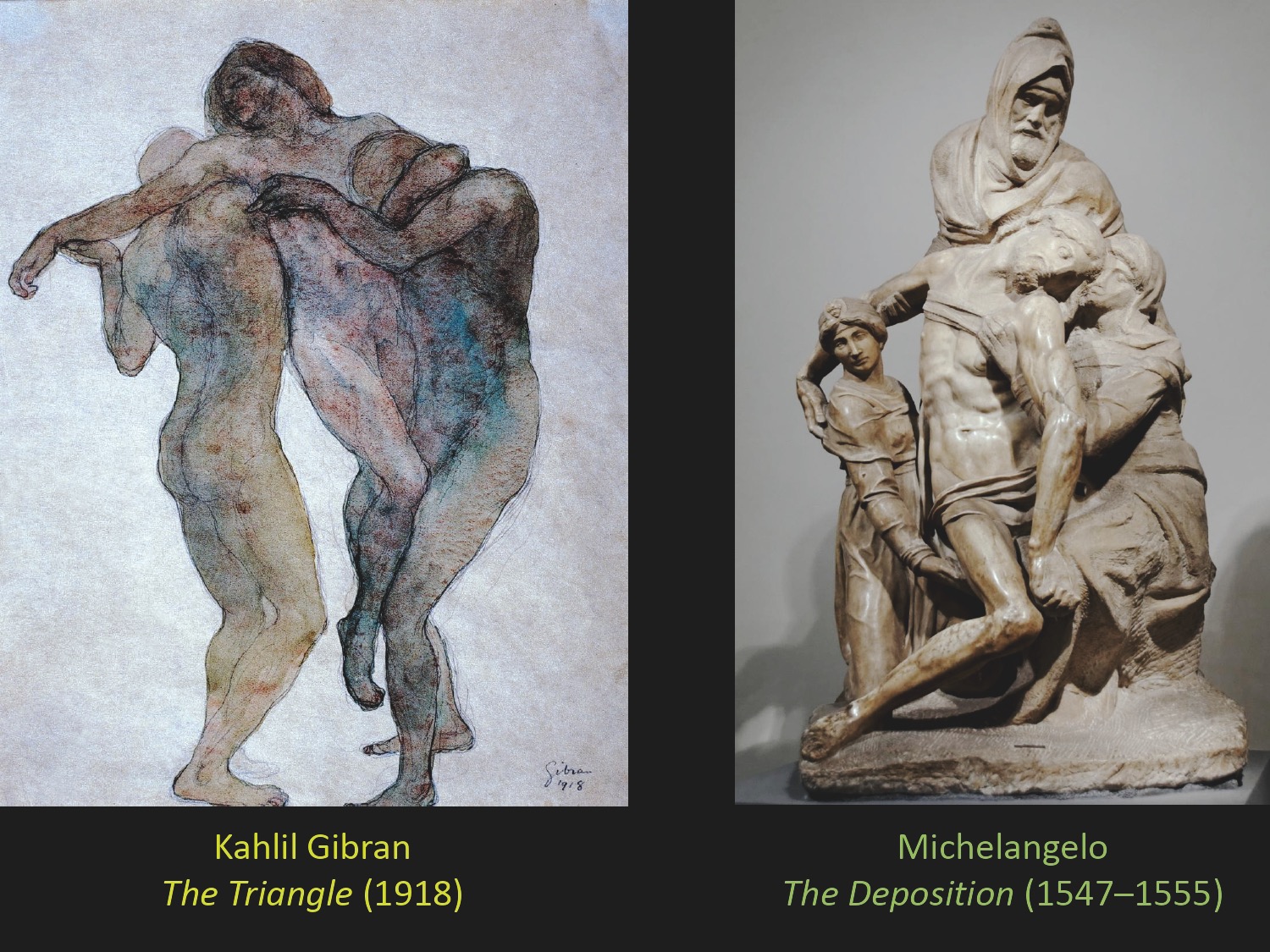 D’Annunzio. But since I grew older and have read his work I realize they were wrong. I cannot do work so good as his.”[40]
D’Annunzio. But since I grew older and have read his work I realize they were wrong. I cannot do work so good as his.”[40]
Gibran was equally fond of western and oriental music. Among his favourite European music styles were symphonies, sonatas and cantatas. In addition to Beethoven and Debussy, he preferred the Italian composer Gioachino Rossini. Joseph Nahas, who was employed as an assistant to Guraieb, met Gibran at the offices of Al-Mohajer. Nahas shares a delightful anecdote about “an Italian barber named Squazzo, who advertised shave and haircut for twenty-five cents […] Squazzo, having a good baritone voice, would be singing music from The Barber of Seville to entertain customers. Both Gibran and I were on the waiting list that particular day for his tonsorial service, and enjoying the rendition. Before leaving, Gibran complimented Squazzo and urged him to seek an audition at the Metropolitan Opera House.”[41]
When Italy declared war on Turkey in 1911, Gibran interpreted it as a sign that foretold the future carving-up of the Ottoman Empire which revived hopes of independence for Syria, but the Italian victory over the Ottomans in Tripolitania merely resulted in Turkey losing those territories and so his hopes were quashed. Nevertheless, he strived to make the Muslim community understand that that war was “not a strife between Mohammedanism and Christianity.”[42] He believed that the Italian bombardment of Beirut in 1912 was an important fact to demonstrate how Turkey was indifferent to the fate of the people of Syria.[43] A figure who appealed to Gibran’s revolutionary sympathies was Giuseppe ‘Peppino’ Garibaldi, the namesake grandson of the popular Italian patriot, who served as General of a brigade in the Greek army during the Balkan Wars, a hero – in his words – who used to go “from one part of the world to another to fight with the people against any form of slavery.” Kahlil fantasized about General Garibaldi leading a regiment of immigrant Lebanese and Syrians to overthrow the Turkish yoke. But Gibran’s activist plans, conceived with his Italian friend,[44] would remain only ‘great dreams.’[45]
Gibran’s standing in Italy, as in the rest of the West, is related mostly to the great success of The Prophet (1923). The first Italian to read The Prophet might have been Eleonora Duse, to whom the author may have given, as suggested by Mary Haskell, a copy of the book in the autumn of 1923, when the famous Italian actress and D’Annunzio’s lover was doing her last tour of the United States.[46] The first Italian edition of The Prophet (Il Profeta) was published in 1936, five years after the author’s death, with a translation by Eirene Niosi-Risos and an introductory essay by the philologist and politician Augusto Mancini, which states: “Writers and books of such elevated and liberated spirituality are worthy of being known and widespread.”[47] The deciding factor in the book’s success in Italy was however its 1968 translation by the poet Gian Piero Bona – published with the English version as a parallel text and still reprinted today – who in his well-grounded introduction comments: “Gibran chose a messenger, an enlightened spokesman who inspired reverence, a prophet by the name of Almustafa. The poet, fearing not being heard, made himself a prophet.”[48] The author of the preface is the late poet, literary critic, university professor and life Senator Carlo Bo, who when commenting on Gibran’s style, confirms that “his poetry bows before prophecy.”[49]
In Italy, The Prophet – alongside other works including Siddartha (1922) by Hermann Hesse, The Little Prince (1943) by Antoine de Saint-Exupéry and Jonathan Livingston Seagull (1970) by Richard Bach – became a cult, which began during the years of the student uprisings. Unfortunately, its circulation – demonstrated by the hackneyed use of quotations, transformed into aphorisms in all manner of contexts[50] – has often provoked a systematic process of either trivialisation or mythicising of the author in the eyes of society, causing the disinterest or hostility of the most authoritative literary critics – on the other hand unable to understand Arab immigrant literature. Furthermore, even in Italy, they made the fatal error of ignoring the era in which Gibran lived and operated – i.e. the decades between the nineteenth and twentieth centuries of the crisis of western values, the Avant-gardes, the progress in technology, the First World War, nascent Arab nationalism – but instead looked at that in which he was rediscovered all over the world – the 1960s and 1970s – a fact which caused a misinterpretation that, from then onwards, never left the author; so much so that it elevated him to the definitive symbol of the hippie generation.
In Italy in particular, Gibran’s writings are often used in Catholic and parochial contexts, substituting in some cases their own sermons, especially for baptisms, weddings and funerals.[51] And so, the works of the poet – who in life was excommunicated by the Maronite Church and even when on his death bed, was still able to summon up his last energies to refuse Christianity and escape the Last Rites – instead ended up becoming a catechism text whilst The Prophet has become an easy, exotic breviary filled with consolatory truths. And that is why in Italian bookstores, Gibran’s works are often found on the shelves with books on religion or worse still – in the esoteric or new age sections.
Great credit is due to the tireless work of Isabella Farinelli who from the late 1980s to the present day – sometimes alongside her sister Giovanna – has translated almost all of Gibran’s works from English into Italian. The translations from Arabic were done by Younis Tawfik, Iraqi journalist and writer, naturalised as an Italian citizen – side by side with the poet Roberto Rossi Testa –, as well as Lebanese author Hafez Haidar and the Arabist Valentina Colombo. On the other hand in 1999, the theologian Edoardo Scognamiglio published the only monograph about Gibran written by an Italian scholar, entitled Il cammino dell’uomo. L’itinerario spirituale di Kahlil Gibran (The Path of Man. The Spiritual Itinerary of Kahlil Gibran). The only Italian display of Gibran’s works was held at the Museum of Folklore in Rome, part of the Lebanese Painting and Handicraft exhibition (8-13 October 1977), organized in the occasion of the canonization of Charbel Makhlouf by Pope Paul VI.[52]
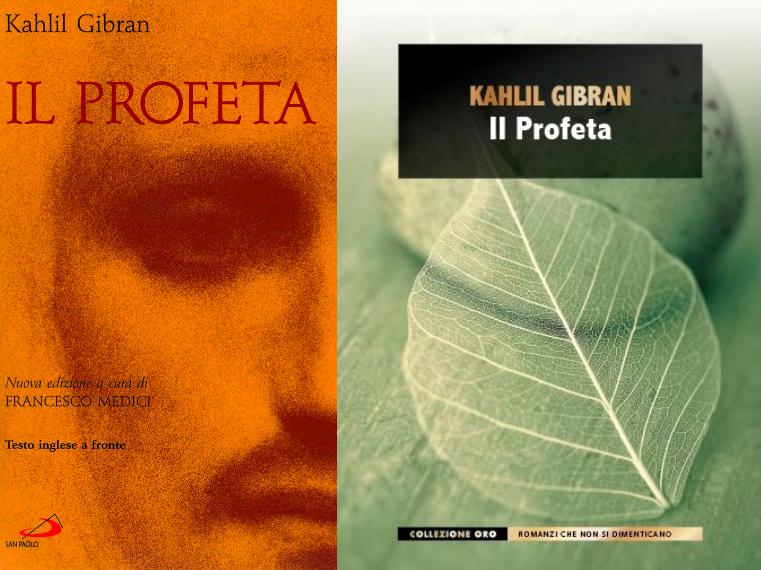 Francesco Medici, Italian literary critic and researcher, translated many of Gibran’s works into Italian (including Lazarus and His Beloved [2001], The Blind [2003], The Prophet [2005]), and also The Book of Khalid (2014) and Juhan (2019) by Ameen Rihani. He edited an Italian version of Gibran’s art book Twenty Drawings (2006), and collected and translated the poetry anthology Poeti arabi della diaspora (Arab Poets of the Diaspora, 2015). Among his contributions: “Il dramma di Lazzaro. Kahlil Gibran e Luigi Pirandello” (The Drama of Lazarus. Kahlil Gibran and Luigi Pirandello, 2002); “Kahlil Gibran. Parlaci della bellezza. Su Venti disegni” (Kahlil Gibran. Speak to us of Beauty. On Twenty Drawings, 2008); “Un abito arabo per Il Profeta. Lettere inedite di Kahlil Gibran a Antony Bashir” (An Arabic Garment for The Prophet. Unpublished Letters from Kahlil Gibran to Antony Bashir, 2010); “Figli dei cedri in America. Il carteggio tra Kahlil Gibran e Ameen Rihani” (Children of the Cedars in America. The Exchange between Kahlil Gibran and Ameen Rihani, 2011); “Gibran in Italy” (2013); “Tracing Gibran’s Footsteps: Unpublished and Rare Material” (2018); “Ameen Rihani’s Juhan: An Arab Christian Author between Islam and Nietzsche” (2018).
Francesco Medici, Italian literary critic and researcher, translated many of Gibran’s works into Italian (including Lazarus and His Beloved [2001], The Blind [2003], The Prophet [2005]), and also The Book of Khalid (2014) and Juhan (2019) by Ameen Rihani. He edited an Italian version of Gibran’s art book Twenty Drawings (2006), and collected and translated the poetry anthology Poeti arabi della diaspora (Arab Poets of the Diaspora, 2015). Among his contributions: “Il dramma di Lazzaro. Kahlil Gibran e Luigi Pirandello” (The Drama of Lazarus. Kahlil Gibran and Luigi Pirandello, 2002); “Kahlil Gibran. Parlaci della bellezza. Su Venti disegni” (Kahlil Gibran. Speak to us of Beauty. On Twenty Drawings, 2008); “Un abito arabo per Il Profeta. Lettere inedite di Kahlil Gibran a Antony Bashir” (An Arabic Garment for The Prophet. Unpublished Letters from Kahlil Gibran to Antony Bashir, 2010); “Figli dei cedri in America. Il carteggio tra Kahlil Gibran e Ameen Rihani” (Children of the Cedars in America. The Exchange between Kahlil Gibran and Ameen Rihani, 2011); “Gibran in Italy” (2013); “Tracing Gibran’s Footsteps: Unpublished and Rare Material” (2018); “Ameen Rihani’s Juhan: An Arab Christian Author between Islam and Nietzsche” (2018).
* This article is based on an excerpt from the paper: F. Medici, Gibran in Italy, in The Enduring Legacy of Kahlil Gibran, Papers delivered at the Second International Conference on Kahlil Gibran: “Reading Gibran in an Age of Globalization and Conflict” (May 3-6, 2012), The George and Lisa Zakhem Kahlil Gibran Chair for Values and Peace at the University of Maryland, edited by S. Bushrui and J. Malarkey, with the assistance of T. Darabi, foreword by G.S. Zakhem, University of Maryland, College Park, 2013, pp. 182-203.
Credits and Thanks to:
The Gibran National Committee
http://www.gibrankhalilgibran.org
[1] M. Naimy, Kahlil Gibran: A Biography, New York: Philosophical Library, 1985, p. 57.
[2] Mary was headmistress of a girls’ boarding school in Boston where she taught using the method developed by Italian educationalist Maria Montessori. “Montessori is epochal” Gibran said to Mary some years later (cf. M.H. journal, Apr. 6, 1913, quoted in J. & K. Gibran, Kahlil Gibran: His Life and World, New York: Interlink Books, 1991, p. 263.
[3] Cf. Y. Huwayyik, Gibran in Paris, New York: Popular Library, 1976, p. 56: “Are you Spanish or Italian?”.
[4] Cf. J. & K. Gibran, Life and World, p. 204.
[5] See M.H. journal, Feb. 22, 1911, quoted in R. Waterfield, Prophet. The Life and Times of Kahlil Gibran, London: Penguin, 1998, p. 149.
[6] Gibran confirmed this story to May Ziadah in 1925 (cf. also S.B. Bushrui & S.H. al-Kuzbari [eds. and trans.], Blue Flame: The Love Letters of Kahlil Gibran and May Ziadah, Harlow: Longman, 1983, p. 88).
[7] B. Young, This Man from Lebanon: A Study of Kahlil Gibran, New York: Knopf, 1945, p. 7. Cf. also J Jabr, Gibran Kahlil Gibran in His Stormy Life, Beirut: Nawfal, 1981, p. 9: “Gibran later told Haskell that his grandfather, Father [Estephan] Rahme, used to host Italian pilgrim priests who stayed at the Mar Sarkis monastery next to Bisharri. They used to bring with them paintings of religious significance. Gibran used to contemplate those paintings for a long time, and wish he would be able to paint similar masterpieces in the future” (quoted in J.H. Helou, Kahlil Gibran. A Nonpareil Artist, Beirut: Joseph D. Raïdy, 2002, p. 18, who continues: “He also copied some of the paintings he had seen painted by the Italian priests who visited his grandfather”, p. 20. It’s worth remembering that the Maronite Christians – to which the Gibrans belonged – are one of the largest Eastern-rite communities of the Roman Catholic Church).
[8] K.G. to M.H., Dec. 19, 1909, quoted in J. & K. Gibran, Life and World, p. 194.
[9] The evocation of a trip to Venice is recounted in his The Master’s Journey to Venice, in The Voice of the Master, translated by A.R. Ferris, New York: Citadel Press, 1958.
[10] K. Gibran, A Self-Portrait, translated from the original Arabic and edited by A.R. Ferris, London: Heinemann, 1960, p. 30.
[11] See K.G. to M.H., Paris, May 10, 1910, quoted in J. & K. Gibran, Life and World, p. 189.
[12] Huwayyik, Gibran in Paris, p. 112. Another young model of Italian origin, who spent time with Gibran in New York during the twenties, was Mariita Giacobbe Lawson, who he used to address as “Princess.”
[13] Anticoli Corrado is a village in the Province of Rome, in the Italian region of Lazio.
[14] Huwayyik, Gibran in Paris, pp. 69, 90.
[15] Ibid., p. 138.
[16] K.G. to M.H., Paris, May 10, 1910 (quoted in The Letters of Kahlil Gibran and Mary Haskell. Visions of life as expressed by the author of “The Prophet”, arranged and edited by A. Salem Otto, Houston: Southern Printing Company, 1964, p. 44).
[17] K.G. to M.H., Paris, June 5, 1910 (quoted in J. & K. Gibran, Life and World, p. 194).
[18] Cf. J. & K. Gibran, Life and World, p. 193.
[19] Therefore Naimy’s account of Gibran’s time in Paris is not entirely accurate: “[…] three years of Paris with visits to Rome, Brussels, London and their rich museums” (A Biography, p. 98). The missed trip to Italy is also confirmed by another of many projects by Gibran to finally visit Italy, mentioned in M.H. journal, Dec. 20, 1914: “Then I can go to Italy and work for the exhibit” (quoted in Beloved Prophet: The Love Letters of Kahlil Gibran and Mary Haskell and Her Private Journal, edited and arranged by V. Hilu, London: Quartet Books, 1973, p. 217).
[20] The 1908 Messina earthquake (also known as the 1908 Messina and Reggio Calabria earthquake) and tsunami took some 100,000-200,000 lives on 28 December 1908 in Sicily and Calabria, southern Italy.
[21] K.G. to M.H., Jan. 3, 1909 (quoted in A. Salem Otto, Letters, p. 19).
[22] K. Gibran, The Arts of the Nations, in Spiritual Sayings, translated by A.R. Ferris, New York: Citadel Press, 1962.
[23] M.H. journal, Apr. 1912 (quoted in Hilu, Beloved Prophet, p. 71). When Mary visited Kahlil in New York, the two often used to dine at Gonfarone’s Italian restaurant (he also liked to eat at Delmonico’s and Moretti’s).
[24] K.G. to M.H., Sept. 22, 1915, quoted in A. Salem Otto, Letters, p. 441.
[25] Letter to May Ziadah, Jun. 11, 1919 (quoted in, Blue Flame, p. 11).
[26] M.H. journal, Sept. 30-Oct. 7, 1922 (quoted in Beloved Prophet, p. 393: “The greatest artist was Titian […] Raphael was just a painter. Someone says of him, he has nothing to say, and says it extremely well. His best period was when he was young, still in Perugino’s studio and under the influence of Perugino.”)
[27] Gibran in Paris, p. 65.
[28] Blue Flame, p. 88.
[29] C. Bragdon, A Modern Prophet From Lebanon, in Merely Players, New York: Alfred A. Knopf, 1929, p. 143. Cf. also A. Raphael, On The Art of Kahlil Gibran, introduction essay to K. Gibran, Twenty Drawings, New York: Knopf, 1919, pp. 1-16.
[30] M.H. journal, Aug. 30, 1913 (quoted in Beloved Prophet, p. 140).
[31] M.H. journal, Sept. 30-Oct. 7, 1922 (quoted in Beloved Prophet, p. 393). Cf. also K.G. to M.H., Feb. 7, 1909, quoted in Otto, Letters, p. 21: “I am sure, dear Mary, that you remember my telling you once of an Arab who went to Italy from the desert and saw the work of Michelangelo and was so moved by its power that he wrote a beautiful poem called ‘The smiling Marble’.”
[32] See also M.H. journal, Jun. 26, 1913, quoted in Beloved Prophet, p. 134: “Kahlil always gets back to Michelangelo and Rodin for illustrations. ‘They sought to express Life’ – Life itself – nothing less.”
[33] Letter to Mikhail Naimy, Mar. 26, 1929, quoted in Naimy, Kahlil Gibran. A Biography, p. 261: “What say you of a book consisting of four stories: Michelangelo, Shakespeare, Spinoza and Beethoven?”
[34] K.G. to M.H., Feb. 8, 1912, quoted in Otto (ed.), Letters, p. 137.
[35] See M.H. to K.G., Mar. 25, 1912, quoted in Otto (ed.), Letters, pp. 158-159.
[36] Huwayyik, Gibran in Paris, pp. 90-91.
[37] Young, This Man from Lebanon, pp. 169-170.
[38] Ibid., p. 80.
[39] K.G. to M.H., May 6, 1912, quoted in Hilu (ed.), Beloved Prophet, p. 78. It was probably the tragic tale of Francesca of Rimini that inspired another of Gibran’s works, The Bride’s Bed, in Tears and Laughter, translated by A.R. Ferris, New York: Philosophical Library, 1947, pp. 87-94.
[40] M.H. journal, Jan. 27, 1911, quoted in Otto (ed.), Letters, pp. 55-56.
[41] J. Nahas, Seventy-eight and Still Musing: Observations and Reflections: With Personal Reminiscences of Gibran as I Knew him, Hicksville, NY: Exposition Press, 1974, p. 49.
[42] K.G. to M.H., Oct. 20, 1911, quoted in Hilu (ed.), Beloved Prophet, p. 52.
[43] See M.H. journal, Apr. 1912, quoted in Hilu (ed.), Beloved Prophet, pp. 75-76.
[44] See M.H. journal, Jun. 22, 1913, quoted in Hilu (ed.), Beloved Prophet, p. 132: “General Garibaldi […] and Kahlil are twins in mind. Garibaldi […] will be great in carrying out of the revolution.”
[45] K.G. to M.H., May 27, 1913, quoted in Otto (ed.), Letters, p. 262. Gibran did not miss the opportunity to add a portrait of General Garibaldi to his “Temple of Art.”
[46] It is impossible to verify whether he was able to carry out her wish due to the actress’ poor health (she died a few months later); cf. M.H. journal, Nov. 26, 1923, quoted in Hilu (ed.), Beloved Prophet, p. 415: “I asked whether he couldn’t send The Prophet to Duse – and so find out whether she wouldn’t be glad to be drawn.” With reference to Duse, cf. also K.G. to M.H., Jan. 26, 1913, quoted in Otto (ed.), Letters, p. 235.
[47] K. Gibran, Il Profeta, introduction by A. Mancini, translation by E. Niosi-Risos, Lanciano, Chieti: Rocco Carabba, 1936, p. XI.
[48] K. Gibran, Il Profeta, preface by C. Bo, introduction and translation by G.P. Bona, Parma: Guanda, 1968, p. 12.
[49] Ibid., p. 8. Among the most important Italian editions of The Prophet, it’s also worth noting Il Profeta, introduction and commentary by S.B. Bushrui, translation by A. Marianni, Milan: Rizzoli, 1993.
[50] Passages from The Prophet have even ended up within the packaging of well-known Italian chocolates “Baci Perugina.”
[51] For example, my translation of The Prophet, Cinisello Balsamo, Milan: Edizioni San Paolo, 2005, was sold in 2010 as a supplement in Famiglia Cristiana (Christian Family), the most popular Catholic magazine in Italy.
[52] This information was given to me by a curator of the Gibran Museum (Bisharri, Lebanon) in September 2001.